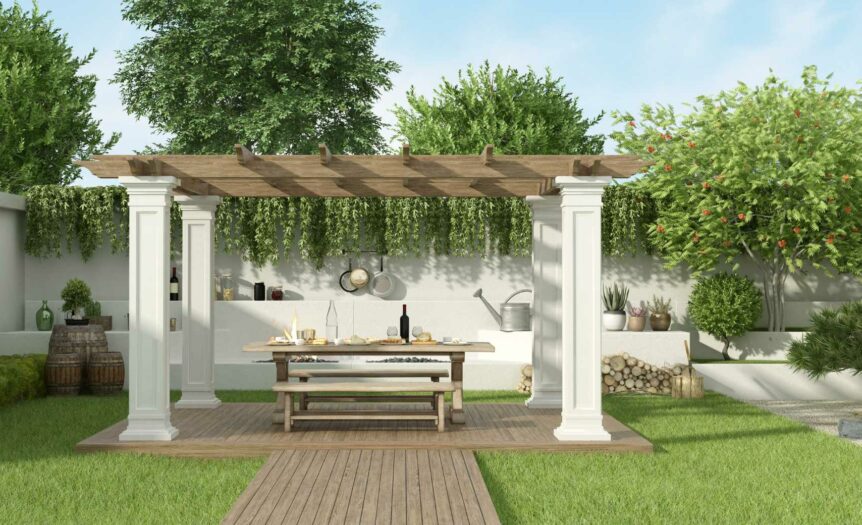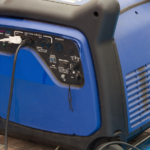A gazebo can be a fantastic addition to your outdoor space, providing shade and an inviting area for relaxation or entertaining. However, with unpredictable weather conditions and high winds, the risk of your gazebo blowing away is all too real.
That’s why it’s essential to know how to keep your gazebo securely anchored and prevent it from taking flight.
Today, we will explore the various causes of gazebos blowing away and share valuable tips on choosing wind-resistant materials, securing them properly with anchoring techniques, and preparing for extreme weather situations.
Key Takeaways
- Proper anchoring and installation are essential for preventing gazebos from blowing away in high winds. It’s important to use sturdy anchors on solid ground, follow manufacturer guidelines, and consider investing in a wind-resistant gazebo.
- Adding weight through sandbags or water-filled weights can help keep gazebos stable during windy conditions. Heavy-duty gazebos made from durable materials like vinyl or metal frames also offer additional protection against strong gusts of wind.
- Closing or removing the canopy during extreme weather events can prevent it from acting as a sail and increasing wind resistance. Regularly checking the anchoring system and using netting or screens around the perimeter of your gazebo are other effective strategies for reducing wind resistance and protecting against blowaways.
Understanding The Causes Of Gazebo Blow-Aways
High wind speeds, improper anchoring and installation, and lightweight gazebo design are the three major causes of gazebo blow-aways.
High Wind Speeds
High wind speeds are one of the primary causes of gazebos blowing away or sustaining damage. As a lightweight outdoor structure, gazebos often have limited resistance to strong gusts or sustained winds.
Several factors contribute to how high wind speeds affect a gazebo’s stability. For example, the design and materials used in its construction play significant roles in determining its ability to withstand strong winds.
A lightweight aluminum frame may be more susceptible to being blown over than a heavier-duty steel one. Additionally, the presence of sidewalls or other wind-breaking features can help reduce the impact of high-speed gusts on your gazebo.
Improper Anchoring And Installation
Proper anchoring and installation are crucial for keeping a gazebo secure and stable. If the gazebo is not anchored properly, winds can easily lift it off the ground and cause damage or injury.
One common mistake is using insufficient anchors or failing to anchor all corners of the gazebo.
Another issue with improper installation is failing to use guy ropes or tie-down straps, which add additional support against wind gusts. It’s important to follow manufacturer guidelines regarding proper anchoring and set up instructions for your specific gazebo model.
Lightweight Gazebo Design
A lightweight gazebo can be a great choice for portability and easy setup, but it also increases the risk of being blown away by strong winds. The lightweight design means that there is less weight to anchor down the structure, making it more susceptible to wind resistance.
If you live in an area with high wind speeds or frequent storms, opting for a heavier duty gazebo or investing in weights and anchoring systems is essential to keep your outdoor shelter secure.
Companies such as Eurmax and Ashman offer various types of gazebo anchoring kits that can be used on different surfaces like concrete or grass, providing stability during windy conditions.
Ways To Secure A Gazebo From Wind
To secure a gazebo from wind, one can choose a heavy-duty gazebo or add weight to the structure through proper anchoring and tie-downs, installing it in a sheltered location, using sturdy anchors on solid ground, or investing in a wind-resistant gazebo.
Choose A Heavy-Duty Gazebo
When selecting a gazebo, it is important to choose one that is heavy-duty and designed to withstand windy weather conditions. Look for gazebos made from durable materials such as vinyl or metal frames that are sturdy and can hold up against strong gusts of wind.
Heavy-duty gazebos will also usually come with thicker canopy material that won’t easily tear or flap around in the wind. Investing in a high-quality gazebo may cost more upfront but it can save you money in the long run by preventing costly damage or replacement due to winds.
Proper Anchoring And Tie-Downs
Anchoring and tie-downs are critical to prevent a gazebo from blowing away in high winds. It is essential to secure the structure to avoid damage or injury from strong gusts of wind.
Ground stakes, sandbags, water weights, leg weights, pegs, and ropes are common options for proper anchorage depending on the surface type. If you’re placing your gazebo on grassy areas or soil surfaces with loose dirt, you may want to use threaded steel tent pegs or screw-in ground anchors.
Proper installation will ensure that your gazebo stays anchored during high winds. It’s important to follow manufacturer instructions carefully when installing your preferred method of anchorage so that it doesn’t fail due to improper installation.
Add Weight To The Gazebo Structure
One of the most effective ways to keep a gazebo from blowing away in high winds is by adding weight to the structure. There are several options available, including sandbags or water-filled weights that can be attached to the legs of the gazebo.
In addition, vinyl gazebos offer an advantage as they come with pre-installed pockets on each leg that can be filled with sand or gravel. This extra weight will help anchor down your gazebo even better than regular tents since it’s up higher above the ground level making it more susceptible to strong wind gusts.
Install The Gazebo In A Sheltered Location
Choosing a sheltered spot can be an effective way to reduce the risk of your gazebo blowing away in high winds. Look for areas that offer natural protection, such as close to walls, fences, or trees.
To provide additional protection from wind and adverse weather conditions, consider using netting or screens around the perimeter of your gazebo.
Remember that prevention is key when it comes to keeping your gazebo secure during windy conditions.
Use Sturdy Anchors On Solid Ground
Securely anchoring a gazebo is an important step in preventing it from blowing away during high winds. Using sturdy anchors on solid ground can make all the difference. Ground stakes, sandbags, and concrete blocks are some of the popular options for anchoring gazebos.
Threaded pegs can also be used to secure the gazebo to grassy or soil surfaces.
Investing in quality anchor kits specifically designed for outdoor shelters like gazebos is a wise choice. These kits often come with everything needed to keep your gazebo securely anchored such as heavy-duty straps, steel stakes, and bungee cords.
Proper placement of these anchors is crucial – positioning them at an angle away from the gazebo will help prevent any possible tipping or lifting caused by harsh gusts of wind.
Tips For Keeping Your Gazebo Secure During Windy Conditions
To ensure your gazebo remains secure during high winds, close or remove the canopy, regularly check the anchoring system, invest in a wind-resistant gazebo, use netting or screens to reduce wind resistance, and make sure that it is properly installed.
Close Or Remove The Canopy
One effective way to keep your gazebo from blowing away in windy conditions is to close or remove the canopy altogether. The canopy acts as a sail, catching and increasing wind resistance which can cause the entire structure to topple over.
If high winds are expected, it is best to completely remove the canopy instead of just closing it. This reduces its weight on the frame and prevents the canopy from flapping around in strong gusts.
Ensure Proper Installation
Proper installation of your gazebo is essential to ensure its stability during windy conditions. Before setting up your gazebo, it’s important to read the manufacturer’s instructions and follow them carefully.
One common mistake that people make when installing gazebos is not anchoring them properly. This can lead to dangerous situations if strong winds occur. Ensure that all anchors are correctly installed into solid ground, such as concrete or hard-packed soil.
Remember, your gazebo is designed for outdoor use but be mindful of where you set it up too. Avoid placing it in areas prone to heavy wind gusts and exposure to severe weather elements like rain or snowfall which may affect its stability over time.
Invest In A Wind-Resistant Gazebo
Choosing a wind-resistant gazebo can be one of the best investments in protecting your structure from high winds. Gazebo manufacturers offer sturdy designs that are designed to withstand strong gusts and keep you and your guests safe.
Some models come with reinforced frames made from stronger materials like aluminum or steel, making them more durable against strong winds. Vinyl gazebos are also an excellent option because they’re more resistant to water damage, mold, and mildew than fabric canopies.
In addition to investing in a sturdier design, other methods such as proper anchoring or adding weights can also help protect your gazebo from being blown away during extreme weather events.
Using sandbags or water-filled weights placed around the perimeter of the canopy can be another way to anchor it securely into place.
Use Netting Or Screens To Reduce Wind Resistance
Another way to protect a gazebo from wind is by using netting or screens. These can help reduce wind resistance and prevent the canopy from tearing.
For example, adding mesh sidewalls to your gazebo not only helps with privacy but also provides added protection during windy conditions.
In addition, using netting or screens also provides an extra layer of safety for those inside the gazebo during windy weather conditions.
Regularly Check The Anchoring System
To prevent your gazebo from blowing away, it is essential to regularly check the anchoring system. Over time, anchors may become loose or damaged, compromising the stability and security of your gazebo.
One way to ensure that your anchoring system remains strong is to tighten all guy ropes and ground stakes periodically. If you notice any fraying or wear on the ropes, it’s important to replace them promptly.
Additionally, if using weights as part of your anchoring strategy, make sure they are intact and haven’t leaked water or sand over time.
What To Do If Your Gazebo Blows Away
If your gazebo blows away, assess the damage and repair or replace any broken or missing parts before re-anchoring it properly to prevent another blow-away.
Assess The Damage
After a strong wind, it’s important to assess the damage caused to your gazebo before attempting repairs. Start by checking for any broken or missing parts of the structure and canopy.
If the gazebo has been blown away entirely, look for any damages on its surface areas as well.
Check also if there are any bent poles, damaged stakes, or ropes that have come loose as they can weaken the structure and make it more vulnerable in future winds.
Repair Or Replace Broken Or Missing Parts
If your gazebo has been blown away or damaged by strong winds, it is important to assess the damage before attempting any repairs. Check for broken or missing parts such as poles, joints, and canopy pieces.
If the damage is minor and can be easily repaired, replace any missing parts and reinforce them with duct tape or glue.
When purchasing a new gazebo, look for one that is designed to withstand high wind speeds and comes with anchoring kits for added stability. Additionally, investing in a wind-resistant gazebo can offer more protection against inclement weather conditions.
Regularly checking the anchoring system of your gazebo can also prevent future incidents of it being blown away by strong winds.
Re-Anchor The Gazebo Properly
If your gazebo has been blown away, re-anchoring it properly is a crucial step in preventing future incidents. Firstly, assess any damages and repair or replace broken parts before installing it back onto the ground.
Make sure to use sturdy anchors on solid ground such as threaded pegs or tethering kits to secure the gazebo legs firmly into place. You can also add weight to the structure with sandbags, leg weights, or water-filled weights to provide additional support against strong winds.
Regularly check the anchoring system to ensure that everything is still intact and adjust accordingly if necessary.
Consider Investing In A More Sturdy Gazebo
If you live in an area prone to high winds or severe weather conditions, it may be worth considering investing in a more sturdy gazebo. A heavy-duty vinyl gazebo with strong metal frames and reinforced anchoring can provide the extra stability needed to withstand even the strongest gusts of wind.
While a sturdier gazebo may come at a higher upfront cost, it could save you money in the long run by reducing potential damage caused by winds. Additionally, a well-built gazebo will last longer and require less maintenance than one made from lightweight materials that are easily damaged by gusty winds.
Conclusion
When it comes to enjoying your outdoor space, a gazebo can be the perfect addition. But in windy conditions, it can quickly become a safety hazard if not anchored properly.
By choosing a heavy-duty gazebo and using proper anchoring and tie-downs, you can help prevent your gazebo from blowing away. Adding weight to the structure or installing it in a sheltered location are also effective strategies.
Remember to check your anchoring system regularly and take down the canopy during extreme weather conditions.
Related Posts
How to keep birds out of my gazebo
Can you put solar panels on a gazebo
What’s the difference between a gazebo and a pavilion
Where to put a gazebo in the backyard
How to hang lights in a gazebo
How to hang gazebo curtains
How to screen a gazebo
How to level a gazebo on sloped concrete
What to do with an old metal gazebo frame
How to move a gazebo
Do you need a permit for a gazebo
How to build a gazebo on a deck
How to anchor a gazebo without drilling
How to decorate a gazebo for a wedding
How much does a gazebo cost
How to build a gazebo roof
What is a gazebo used for
What is the difference between a gazebo and pergola






